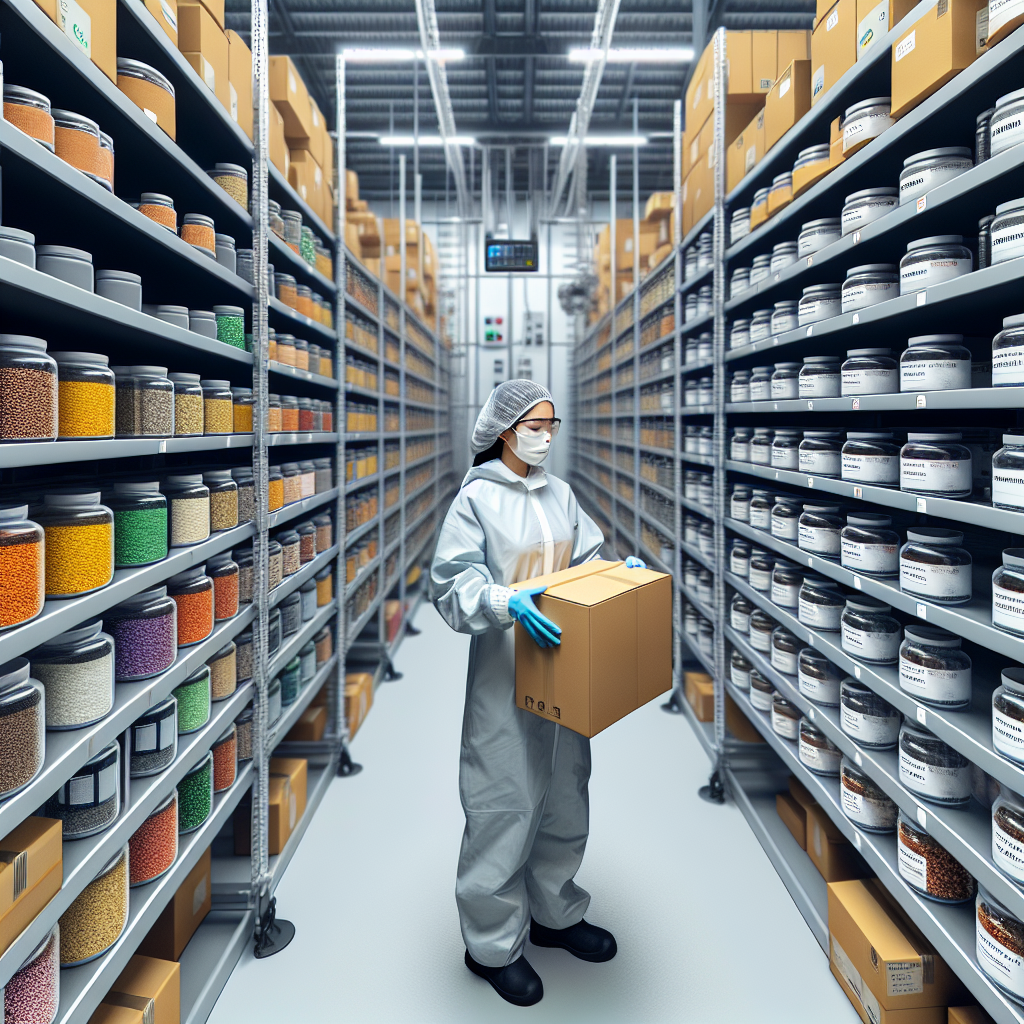In the competitive world of supplement manufacturing, the smallest details often make the biggest difference in product quality. While many manufacturers focus extensively on formulation, packaging, and marketing, one critical factor frequently flies under the radar: raw material storage temperature and humidity control. This overlooked aspect of production can silently undermine product quality, potency, and shelf life, potentially damaging your brand reputation and bottom line.
For forward-thinking supplement manufacturers and health-conscious product developers, proper environmental control isn’t just a good practice—it’s essential to maintaining ingredient integrity and ensuring consistent product efficacy. The hidden dangers of neglecting temperature and humidity controls can manifest in reduced potency, contamination, degradation of active ingredients, and ultimately, dissatisfied customers.
The Critical Importance of Climate Control for Raw Materials
Maintaining optimal raw material storage temperature and humidity is fundamental to preserving the quality and integrity of ingredients used in health supplements and nutritional products. Many bioactive compounds are particularly vulnerable to environmental factors, with their molecular structures becoming compromised when exposed to improper conditions. Proper storage practices directly impact product efficacy and brand reputation.
Consider vitamin C, a common ingredient in many health supplements. Research from Purdue University food scientists revealed that vitamin C begins to deteriorate when humidity levels exceed 80 percent. Similarly, many amino acids, enzymes, and probiotics are extremely sensitive to temperature fluctuations. For instance, probiotic strains begin to lose viability at temperatures above 77°F (25°C), while certain enzymes can denature when exposed to temperatures outside their optimal range.
“Temperature and humidity control isn’t just about compliance—it’s about protecting the very essence of what makes your products effective,” explains Dr. Jennifer Morris, a formulation specialist. “When raw materials are compromised at the storage level, no amount of careful manufacturing can reverse that damage.”
For manufacturers specializing in premium health products, proper raw material storage temperature and humidity control represents an investment in product quality. By maintaining strict environmental controls, companies can ensure that ingredients retain their full nutritional value, bioavailability, and efficacy from receipt through production.
Optimal Storage Conditions: Setting the Standard
Establishing and maintaining proper raw material storage temperature and humidity levels requires understanding the specific requirements of different ingredient categories. While requirements may vary based on specific ingredients, there are generally accepted standards that serve as guidelines for supplement manufacturers:
Temperature Guidelines:
- Most shelf-stable ingredients: 59-77°F (15-25°C)
- Heat-sensitive compounds (probiotics, enzymes): 35-46°F (2-8°C)
- Oils and fatty acids: 50-65°F (10-18°C)
- Freeze-dried materials: Below 68°F (20°C)
Humidity Guidelines:
- General raw materials: 30-50% relative humidity
- Hygroscopic materials (those that absorb moisture): Below 30% relative humidity
- Moisture-sensitive ingredients: Below 40% relative humidity
Deviations from these optimal raw material storage temperature and humidity parameters can trigger a cascade of quality issues. When temperatures rise above recommended levels, chemical reactions accelerate, potentially causing:
- Breakdown of active compounds
- Loss of potency
- Formation of degradation products
- Increased microbial growth risk
- Changes in physical properties (melting, clumping)
Similarly, improper humidity control can lead to:
- Moisture absorption by hygroscopic materials
- Accelerated oxidation
- Mold and bacteria growth
- Caking or clumping of powders
- Reduced flow properties
A study examining the stability of vitamin supplements found that those stored at elevated temperatures (above 86°F/30°C) and high humidity (above 75%) lost up to 30% of their labeled potency within just six months. This dramatic reduction illustrates how proper raw material storage temperature and humidity controls directly impact the value delivered to consumers.
Essential Monitoring Tools: Investing in Quality Assurance
For manufacturers serious about maintaining optimal raw material storage temperature and humidity conditions, implementing robust monitoring systems is non-negotiable. Thermohygrometers—devices that measure both temperature and humidity simultaneously—have become essential investments for quality-focused operations.
Modern monitoring solutions range from basic standalone units to sophisticated systems that offer:
- Continuous real-time monitoring
- Alert notifications when parameters exceed acceptable ranges
- Data logging capabilities for quality assurance documentation
- Remote monitoring through cloud-based platforms
- Calibration verification features
“Implementing continuous monitoring rather than periodic checks can prevent costly ingredient losses,” notes Sarah Jenkins, a quality assurance director at a leading supplement manufacturer. “We discovered temperature fluctuations during overnight hours that were compromising our raw materials—an issue we would have missed with manual daily checks.”
Regular calibration and maintenance of these monitoring tools are equally important. Even the most advanced systems require verification to ensure accuracy. Industry best practices recommend:
- Quarterly calibration verification of all monitoring devices
- Backup monitoring systems for critical storage areas
- Regular staff training on monitoring protocols
- Documented temperature mapping of storage facilities
- Scheduled review of environmental data logs
By investing in proper monitoring of raw material storage temperature and humidity conditions, manufacturers can prevent quality issues before they occur. These proactive measures not only protect ingredient integrity but also provide documented evidence of quality control practices—an increasingly important factor for regulatory compliance and customer confidence.
Environmental Factors: Beyond Basic Controls
While maintaining optimal raw material storage temperature and humidity is essential, several additional environmental factors can impact storage conditions and require specific mitigation strategies.
Direct Sunlight Exposure
UV radiation can trigger photodegradation of sensitive compounds, particularly vitamins and natural colorants. Storage areas should be designed to eliminate direct sunlight exposure through:
- UV-filtering window films
- Opaque storage containers
- Light-controlled environments
- Strategic facility layout to avoid sun-exposed areas
Air Quality and Ventilation
The quality of air circulating in storage areas can introduce contaminants or affect humidity levels. Proper ventilation systems should:
- Filter incoming air to remove particulates
- Maintain positive pressure in clean storage areas
- Control airflow to prevent temperature stratification
- Include HEPA filtration for sensitive materials
Thermal Cycling
Fluctuations between temperature extremes can be more damaging than consistent non-optimal conditions. To prevent thermal cycling:
- Implement buffer zones between loading areas and primary storage
- Install rapid-roll doors to minimize environmental exchange
- Use thermal mass elements to stabilize temperatures
- Position temperature-sensitive materials away from external walls
Spatial Considerations
Even within a single storage area, conditions can vary significantly. Temperature mapping studies often reveal:
- “Hot spots” near mechanical equipment or lighting
- Cooler areas near external walls during winter
- Humidity gradients based on proximity to doors or windows
- Vertical temperature stratification (warmer at ceiling level)
By addressing these additional environmental factors alongside basic raw material storage temperature and humidity controls, manufacturers can create more robust systems that protect ingredient quality under real-world conditions. Industry research confirms that comprehensive environmental management significantly extends ingredient shelf life.
NutraAeon’s Commitment to Quality Through Optimal Storage
At NutraAeon, our core philosophy of Quality, Transparency, and Empowerment aligns perfectly with the critical importance of proper raw material storage temperature and humidity control. As a trusted global partner for nutritional ingredient sourcing, we understand that the quality chain begins with proper storage conditions from the moment ingredients are harvested or produced.
Our comprehensive approach to quality includes:
- Climate-controlled warehousing facilities designed specifically for nutritional ingredients with segregated zones for temperature-sensitive materials
- Continuous monitoring systems that track raw material storage temperature and humidity 24/7 with alert protocols for any deviations
- Complete documentation of environmental conditions throughout the supply chain, providing customers with full visibility
- Technical expertise in ingredient-specific storage requirements for our specialized Amino Acid, Vitamin, and Mineral Series
“What sets NutraAeon apart is our understanding that quality isn’t just about meeting specifications at a single point in time—it’s about maintaining optimal conditions throughout an ingredient’s journey,” explains our Quality Assurance Director. “Our raw material storage temperature and humidity protocols are designed to preserve the full potency and efficacy of every ingredient we supply.”
For manufacturers seeking premium nutritional components, NutraAeon’s expertise in environmental control represents a significant advantage. Our technical team regularly consults with partners on establishing and maintaining optimal storage conditions, empowering them to extend the quality controls we implement into their own facilities. Visit our raw materials resources for more information.
The Call to Excellence: Prioritizing Climate Control in Your Operation
As consumer expectations for supplement efficacy continue to rise, forward-thinking manufacturers must elevate every aspect of their quality systems—starting with raw material storage temperature and humidity control. The stakes are simply too high to overlook this fundamental aspect of ingredient integrity.
Consider implementing these action steps to enhance your climate control practices:
- Audit your current storage conditions against ingredient-specific requirements, identifying gaps in temperature and humidity controls
- Invest in appropriate monitoring technology that provides continuous oversight of environmental conditions
- Develop standard operating procedures for responding to climate control deviations
- Train all personnel on the importance of proper raw material storage temperature and humidity management
- Partner with suppliers like NutraAeon who prioritize and document climate control throughout the supply chain
Remember that proper environmental control is not merely a regulatory checkbox—it’s a competitive advantage that directly impacts product efficacy, consistency, and consumer satisfaction. By making raw material storage temperature and humidity control a priority, you demonstrate your commitment to quality at every level of your operation.
In today’s quality-driven marketplace, consumers increasingly recognize and reward brands that deliver consistent results. By ensuring that your raw materials are stored under optimal conditions from receipt through production, you’re not just protecting ingredients—you’re protecting your brand promise and building a foundation for long-term success.
The question isn’t whether you can afford to implement proper raw material storage temperature and humidity controls—it’s whether you can afford not to.


